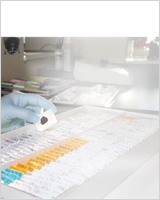| 1 | Study details | |
| 1.1 | Study ID | MIABIS 2.0 |
| 1.2 | Study name | MIABIS 2.0 |
| 1.3 | Description/objective | MIABIS 2.0 |
| 1.4 | Responsible unit | |
| 1.5 | Responsible/principal investigator | MIABIS 2.0 |
| 1.6 | Sample manager | |
| 1.7 | Study design | MIABIS 2.0 |
| 1.8 | Cancer type | WHO name or ICD-O code |
| 1.9 | Other chronic disease | BRISQ |
| 2 | Collaborators details | |
| 2.1 | Contact person (collaborators)
– First name
– Last name
– Telephone number
– Email
– Contact institution
– Contact department
– Contact address
– Contact country | MIABIS 2.0 |
| 3 | Collection details | |
| 3.1 | Collection start date | |
| 3.2 | Collection end date | |
| 3.3 | Collection centres
– Centre name
– Centre country | |
| 4 | Ethical, legal, and social issues (ELSI) | |
| 4.1 | Ethical approval
– Date
– Reference | |
| 4.2 | Informed consent | |
| 4.3 | Participant information sheet | |
| 4.4 | Material Transfer Agreement
– Date
– Reference | |
| 4.5 | Other contract
– Date
– Reference | |
| 5 | Donor/patient-related data | |
| 5.1 | Sample ID | |
| 5.2 | Parent sample ID (for aliquots and derivatives) | |
| 5.3 | Informed consent
– YES/NO/NI (implying waiver)
– Type of consent
– Area of research
– Re-contact
– Return of results
– Access to medical data
– Possibility to publish data
– Access to genetic data | |
| 5.4 | Sex | |
| 5.5 | Age at collection | |
| 5.6 | Country and region of origin | |
| 5.7 | Basic diagnostic parameters (e.g. for cancer: individual TNM codes where possible; if not, then stage and always grade – for all, the version should be indicated) | |
| 5.8 | Associated diagnostic parameters (CA125, CA19-9, etc.) | |
| 5.9 | Other diseases | |
| 5.10 | Disease status | |
| 6 | Biospecimen-related data | |
| 6.1 | Biospecimen type | |
| 6.2 | Anatomical site: organ of origin or site of blood draw | |
| 6.3 | Collection mechanism: how the biospecimens were obtained | |
| 6.4 | Type of stabilization: the initial process by which the biospecimens were stabilized during collection | |
| 6.5 | Biospecimen size | |
| 6.6 | Delay to preservation:
– Time between biospecimen collection and processing
– Time between biospecimen processing and cryopreservation
– Warm ischaemia time for tissue: period between circulatory arrest and beginning of cold storage | SPREC |
| 6.7 | Temperature before preservation:
– Storage temperature before processing
– Storage temperature before cryopreservation | |
| 6.8 | Type of long-term preservation: the process by which the biospecimens were sustained after collection | SPREC |
| 6.9 | Constitution of preservative: the make-up of any formulation used to maintain the biospecimens in a non-reactive state | |
| 6.10 | Storage temperature for short-term storage: the temperature, or temperature range, at which the biospecimens were kept until distribution or analysis | |
| 6.11 | Storage temperature for long-term storage | SPREC |
| 6.12 | Freeze–thaw cycles: this field is for low-temperature storage and should account for the number of times the sample underwent a freeze–thaw cycle for processing; it should also account for any anomalies to the container containing the samples | |
| 7 | Categories of associated data collected | |
| 7.1 | Medical history data (e.g. history of other diseases, medications, family history of same cancer to first and second degree, family history of other cancers, family history of other diseases):
– Available or not?
– Which kind of data?
– Where are data kept?
– Who manages data? | |
| 7.2 | Epidemiological and survey data (e.g. age, sex, exposure, anthropometric data, reproductive history, physical activity, tobacco status, alcohol consumption, occupational history, socioeconomic status, previous illness):
– Available or not?
– Which kind of data?
– Where are data kept?
– Who manages data? | |
| 7.3 | Clinical data (e.g. clinical diagnosis, clinical presentation, comorbidities, biochemical data, immunophenotypic data, neoadjuvant therapy, disease status of patients, vital state of patients, clinical diagnosis, pathology diagnosis):
– Available or not?
– Which kind of data?
– Where are data kept?
– Who manages data? | |
| 7.4 | Pathology data (e.g. pathology diagnosis, histological type, TNM, stage, grade, nuclear component, immunohistochemistry):
– Available or not?
– Which kind of data?
– Where are data kept?
– Who manages data? | |
| 7.5 | Follow-up data (e.g. bioassays, treatment, disease progression, relapse, status – disease-free, alive with disease, dead from disease, dead from other causes):
– Available or not?
– Which kind of data?
– Where are data kept?
– Who manages data? | |
| 8 | Shipment data saved for each sample | |
| 8.1 | Date of deposition | |
| 8.2 | Number of biospecimens shipped | |
| 8.3 | Shipment conditions | |
| 8.4 | Carrier | |
| 8.5 | Date of next shipment | |
| 8.6 | Number of biospecimens to be shipped | |
| 8.7 | Expected carrier | |
